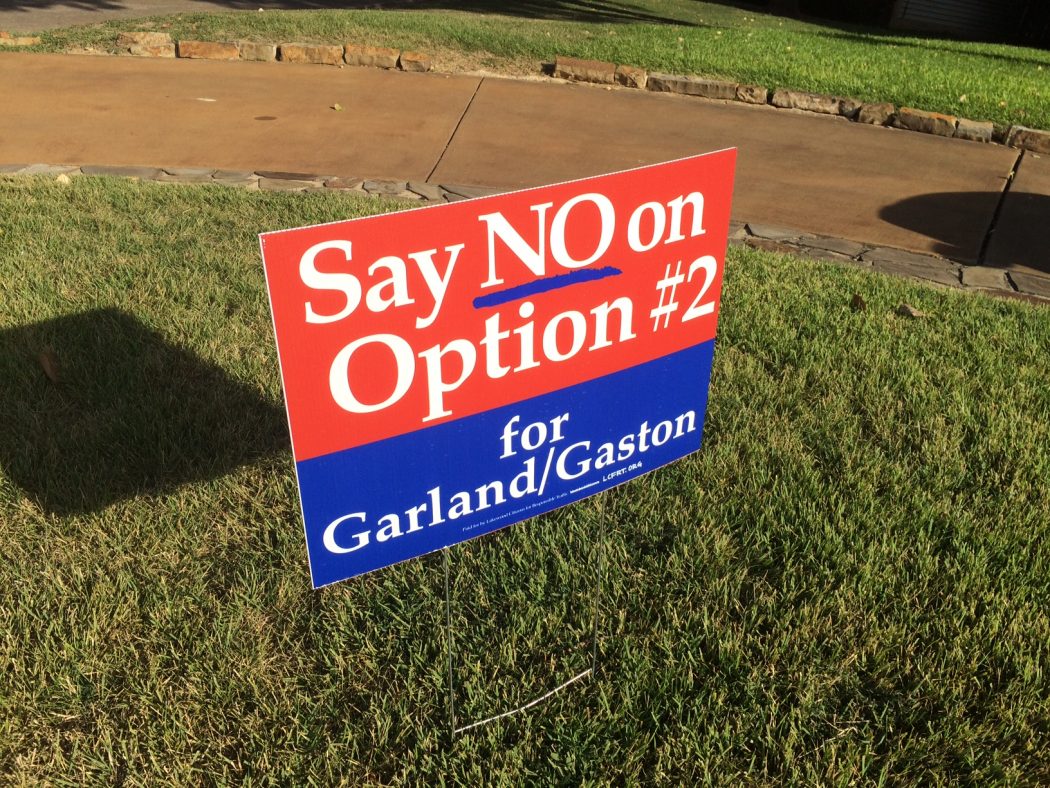
The signs
Anyone who has driven down Gaston Avenue recently can’t help but notice the red, blue and white signs telling you to “Say NO on Option #2 for Garland/Gaston.” In a rare moment of bipartisanship, the signs share yards with both Beto and Pete Sessions signs on Gaston.
The signs are part of an effort by a group called the Lakewood Citizens for Responsible Traffic (LCFRT), who are doing everything they can to get the Texas Department of Transportation (TxDOT) to reconsider their preferred design for the intersection.
Is this on the ballot for November? Is there a chance for neighbors to vote? The short answer is no, but that isn’t stopping the group from encouraging neighbors to contact their city and state representatives and make themselves heard. Their website encourages neighbors to contact representatives and TxDOT to voice their opposition to the preferred option, called a “Reverse T.”
TxDOT confirmed that a vote is not in the works. “Voting on road projects is not a part of the process, however, a formal public hearing will be scheduled where citizens can voice their comments in writing and from the microphone. TxDOT has held several public and stakeholder meetings,” they wrote via email.
Elizabeth Blackburn and Sarah Lamb, who live on Gaston, are helping lead the group, which is made up of neighbors from throughout East Dallas. While there isn’t a clear path to changing TxDOT’s mind, the group is pushing forward anyway.
The group prefers Option 1, the second-favorite choice during the original process. Option 1 is a traditional intersection design, and provides crosswalks all the way around with a fourth node that would lead into The Lot’s parking lot. The complicated left turn/yield situation when turning from northbound Grand onto westbound Gaston would be eliminated, as would the lane that never stops going from northbound Grand onto Garland. The two right turn lanes from Garland to Gaston would remain. They hope to bring awareness to the issue, even though Option 1 is not on the table right now.
“I don’t know why they would want to move forward with such a contentious project,” Blackburn says.
The options
TxDOT prefers the Reverse T, which received a letter of support from city staff, but another option would be to do nothing at all to the intersection. District 14 councilman Philip Kingston says that city staff made that recommendation without running it by council — something he wants to avoid moving forward.
District 14 is one of three council districts that abut the intersection, and Kingston isn’t happy with TxDOT’s process or results. “It has been a sham of a public process from the beginning,” he says. A small group of stakeholders selected Option 2 in December of 2016, but the LCRFT group wishes there would have been more public input earlier in the process.
Kingston says he would gladly take doing nothing over Option 2, and is working with District 9’s Mark Clayton to come up with a compromise that doesn’t cause such a traffic increase on Gaston. He says they city can offer an alternative “locally preferred option” to TXDOT.
“There are enough similarities that we should be able to find common ground to alleviate their concerns and ensure that it is a successful project,” Clayton says.
Option 2 would push more traffic onto Gaston than exists right now, and LCFRT wants to maintain traffic at current levels. Currently, there are around 18,000 vehicles per day (vpd) that go from southbound Garland to westbound Gaston, but Option 2 would up that number to 29,000 vpd in 20 years. TXDOT prefers Option 2 because it would improve safety, slowing cars down by ending the straight shots in the intersection and controlling all movements with stoplights, rather than have the double free right turn lanes and straight shots that exist now. The Reverse T would also reduce peak hour wait times compared to the existing intersection.
“It is obvious though that Option 2 will reduce the number of cars that take Grand due to the new road alignment towards Gaston, forced left turn, and the reduction in the number of lanes that will go through from Garland to Grand. Option 1 is more balanced because it maintains the existing lane counts and alignment,” Blackburn wrote via email.
By the City of Dallas’ own measures, Gaston is already over capacity. According to the city’s Thoroughfare Plan, Gaston Avenue is designated as a “Community Collector,” which is supposed to max out at 14,000 vpd. Garland/Grand is considered a 6 lane principal arterial, which is meant to hold 21,000 vpd. For LCFRT, it doesn’t make sense to continue to overload Gaston via Option 2, whose path make it easier to turn onto westbound Gaston and require a left turn to stay on Grand from southbound Gaston.
What’s next?
LCFRT would like to see both options presented at a future public meeting, allowing neighbors to vote on their preferred option. TXDOT will have another public hearing this fall, though the agenda of the meeting is not set. Construction will begin in 2021.
“We all want to be good neighbors, but we want to make sure that traffic goes where traffic should go,” Clayton says. “I think we can get to that point.”
“The message I have for people on Gaston is they have been heard loud and clear,” Kingston says. He wants to do a complete street study for Gaston to make it more amenable to pedestrians and cyclists. “Regardless of what happens, I am 100 percent committed to making Gaston a safer road.”





